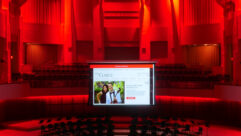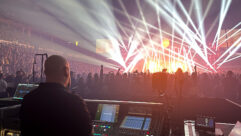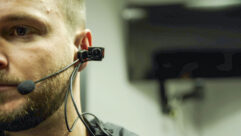
In the process of delivering shows within the live events industry, the backstage has traditionally been considered this elusive and hidden space where all the ‘magic’ happens. The reality is that backstage can be a very dangerous place, especially for people unfamiliar with a show site environment. For many years, the importance of the backstage look and layout was ignored compared to the front of house and show stage. Today, a new trend has emerged where the design of the backstage has become a great concern. Staging companies are realizing that the end client, aka the person paying for the event, typically spends some amount of time backstage, and an organized environment not only demonstrates a high degree of professionalism, but also assists in executing a successful show.
Normally, the backstage is an area with road cases scattered everywhere, cables running in all directions, multiple equipment areas with loads of power running into expensive gear, along with scaffolding towers and scissor lifts. Additionally, the backstage is a very dimly lit environment, making it difficult to see trip hazards and creating unsafe areas. Simply put, there are many things in the backstage that can hurt people; and our job is to create a safe environment for technicians working and guests walking through the area. The main goal of the backstage is to house much of the gear that keeps the show running, and taking the time to provide an organized and safe environment can become secondary in the setup process.
While the goal of running the show will always take the top priority, taking the time to plan a functional and safe environment is well worth the investment. It’s a good bet at some point in the process of setting up a show, the client will come backstage. This can be anyone – such as the event planner that hired the staging firm and/or the CEO of the company holding the meeting. In many cases, they might bring guests. It’s their show, and they can bring anyone backstage at any point in the process. In addition, there are also keynote presenters and other speakers backstage at times, entertainment/musical performers, and in some cases even audience members brought onstage via the backstage area. You never know who you might have coming through the area, and a well-managed and organized backstage can act as a selling point to showcase the inner mechanics of an efficient technical provider.
Setting up a presentable and safe backstage atmosphere, with clearly lit pathways, cable ramps, and well-organized equipment areas can set the tone for the event. It sends a message to the client that they are working with a technical provider that not only cares about what the audience sees, but also what they don’t see. A disorganized backstage can be comparable to going over someone’s house and it may seem clean on the surface, but you then open a closet and everything is piled up in a big heap. An organized backstage may not win any awards, but a cluttered and disorganized environment can leave a bad impression.
Working with a technical provider that puts extra time into planning an organized backstage can also help with mitigating the risks involved during the show. Live events have many points of failure. Having each technical area, such as the video, audio, and lighting villages of the backstage, separate and orderly, and any backup equipment for each discipline easily accessible, can be important factors. Should an issue arise during the event, a technical provider that has all the gear arranged properly and knows exactly where key items are located will be in a better position to solve problems and handle any technical challenges. A well-organized backstage can also speak to the level of provider on the show, as they see the value in a providing a presentable, safe, and efficient workspace, and hold a higher standard when it comes to their performance.
A live event has so many different components, and the backstage plays an important role. As events become even more complex in this era with so many different innovative technologies widely available, it’s more important than ever to keep the backstage in order. Having a strategy in place for the backstage that incorporates a presentable atmosphere, safe pathways and areas for visitors, and efficient layout for equipment can truly make a difference in the overall success of the show as well as help with avoiding legal entanglements. People tripping over cables, bumping into cases, and inaccessible equipment to fix issues are a few examples of the pitfalls that can be easily avoided with some extra planning. Working with a company that cares about the image they are conveying to the client, and provides a safe and well thought out backstage area is a winning proposition, and increases the chance of executing a successful show. Keep your house in order.










